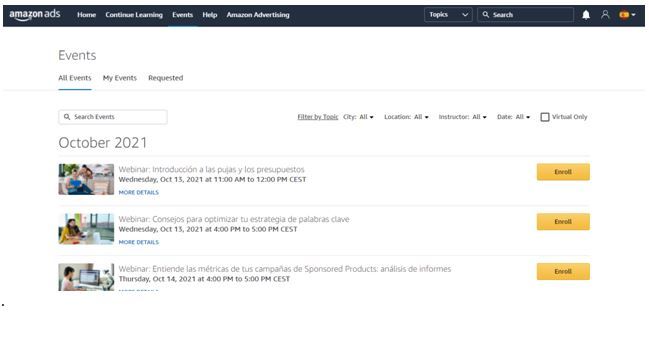
You will need to take into account your business, marketing goals, products and competitors when deciding on the best bidding strategy for Amazon campaigns. Continual testing and analysis is important to ensure that you're not overpaying or underpaying for clicks.
Amazon offers many bidding methods, including fixed and dynamic auctions as well as rule-based. Each one can easily be adapted to fit your needs and goals.
Dynamic Auction
Amazon's dynamic auction feature lets sellers adjust their bids in real-time based on whether a click will convert into a sale. It uses several algorithms to determine which ads are most likely to convert based upon historical data and buyer behaviors.
Dynamic bidding allows you to increase or decrease your bids based upon your ad's likelihood of being purchased. This is best when you are trying to win placements at top search results or product pages. Amazon increases bids up to 100% for auctions that are most likely convert.
Another dynamic bidding strategy is dynamic bids - down only, which allows you to set a fixed bid amount and then let Amazon automatically reduce your bids by up to 100% if it rates your ad as less likely to convert. This option is good for budget control as it allows you spend less on ads that are less likely convert. It also gives you search data and impressions.
Dynamic bids go up and down

Amazon has added Dynamic bidding as a feature to their Sponsored Product ads. Dynamic Bidding allows you to optimize your bids based upon how likely your keyword, product category, or product to convert sales.
There are two different dynamic bidding strategies - "Dynamic bids - down only" and "Dynamic bids - up and down". Amazon lowers your bids upto 100% if Amazon rates your keywords or products less likely of conversion.
The best dynamic bidding strategy for your campaigns depends on your goals and the products you are competing against. Most cases, you should switch from the default strategy of "down only" to "up & down" as soon as your product has enough data for the AI to work properly.
Match each auto bidding strategy to a campaign goal
Automated bid strategies employ machine learning to optimise bids for you based upon campaign goals. They are compatible with text ads, Dynamic Search Ads, and shopping campaigns.
To maximize results and achieve your goals, it is crucial to match each auto bidding strategy with the right campaign goal. This is best done by regularly evaluating and adjusting the strategy to ensure that it remains in line with your campaign goals.
Maximize Clicks is a strategy that sets bids to maximize clicks for your ads while keeping costs within a budget. It's the ideal strategy for advertising campaigns that prioritize driving traffic to a website or mobile app.

Another bidding option that's great for a profit-driven approach is the Fixed Bid strategy. Amazon can preserve its ad spend when it believes that sales conversions are unlikely.
This is a great option for accounts that manage multiple brands or products from a variety of product lines. This allows you, by separating ad expenditure by portfolio grouping, to make adjustments and analysis for each cluster.
Default bid
Amazon auctions Sponsored Product and brand ads on a cost–per-click (CPC). Each advertiser submits an initial bid. This determines how much they will pay per click.
A Amazon Bidding campaign offers a starting CPC as well as one of three bidding strategy options. You also have the option to adjust your placement bids. With the option to change your default bid, you can customize your ad campaign to meet your specific advertising goals.
Amazon offers dynamic up-and-down bids that allow you to adjust your bids according to the likelihood of conversion. Amazon increases your bid for placement on the first page of search results if it considers that clicking will result in conversions. Amazon decreases your bid 50% for placements other than those mentioned.
FAQ
Why it is important to make a shopping list?
A shopping list serves one purpose: to remind you of what you need for grocery shopping. You won't have to run around searching for the items you forgot. A shopping list makes it easy to find items if it is not in the right aisle.
You will also save money by having a shopping list. You can save money by having a shopping list.
How can I avoid being scammed online when buying?
Be vigilant when you shop online. Before you make a purchase online, be sure to read reviews and review the feedback of customers. Don't send sensitive financial information by email. Instead, make use of a secure site such PayPal. So you can rest easy knowing your information is safe.
How can I shop online for the best clothes at the lowest price?
There are several things that you can do to ensure that you get the best deal when you shop for clothes online. Free shipping is a great option. These promotions often include free shipping within Australia.
Second, you should check out the return policy of the website you plan to buy from before making a purchase. Some websites allow you the right to return your items within 30 calendar days after they arrive. Others only allow you to return them within 14 days.
Third, look into customer reviews of the retailer you're considering buying from. You'll be able to determine if they are trustworthy and reliable.
Fourth, compare prices between different retailers. There are many websites where you can compare prices from different retailers.
Don't forget to look out for coupon codes or sales on certain brands and clothing types. Keep checking the site for any new discounts.
Is it worth signing-up for insider and reward programs at your local shop?
While rewards are wonderful, they may not be worth the effort. If you do decide to join an online program, make sure there is value in what you are getting. Be sure to know what you will be spending your time and money on.
If you are signing up for a rewards card just because it has a good signup bonus, be careful. Sometimes these signup bonuses are not worth the hassle.
It is important to ask yourself why you want a reward program before you join. Many people join because they see their friends doing it. But if you have no interest in the products or services offered by the company, then you probably won't stick with it long enough to reap any rewards.
Statistics
- According to the Federal Trade Commission (FTC), online shopping was the fourth most common fraud category for consumers as of February 2022.5 (thebalance.com)
- A report from the U.S. Census Bureau found that in the first quarter of 2022, an estimated $250 billion was spent on retail e-commerce sales.1 (thebalance.com)
- An approximately 90% increase in price affords Hotel X the opportunity of extreme profits under severe circumstances. (dos.ny.gov)
- Last Black Friday, I bought a stove from Lowes at 40% off, receiving 24 months of interest-free financing (from Lowe's). (meetfabric.com)
External Links
How To
What are safe online shopping skills?
Safe online shopping is an important skill for anyone who wants to shop online safely. It's also great to learn how to buy from different websites without getting scammed.
Read on if you want to know what to do when buying items online! This article will give you all the tricks and tips necessary to ensure that you don’t fall for a scam.
-
Do your research. Before you decide to shop online, it's essential to do your homework first. Look for reviews and customer feedback about the company that you are considering buying from. Ask friends for recommendations.
-
Shop around. If you're unsure whether a particular store is reputable, compare prices among several sellers. Consider price comparison apps like Amazon Price Checker or Google Shopping. These tools let you see which retailers have the lowest prices.
-
Be aware of red flags. You should be alert for any red flags when you browse product pages. Many sites are fake and contain misspelled words as well as grammatical errors. These sites often sell fake products or incomplete products.
-
Beware of popups. Pop-ups are sometimes used by websites to collect passwords or credit card numbers. If you are confronted with one of these, please close it by pressing "escape", or select another browser window.
-
Ask yourself questions. When you visit a website, think about the following questions: Does this website seem trustworthy? Do they offer the services I require? Can I trust the people behind the site?
-
Don't reveal your personal data. Unless you initiated the transaction or provided financial information, do not give out your Social Security number, bank account numbers, or credit card details by phone or email.
-
Do not click on links in emails. It is very easy to click links in emails and end up on a fake website. This type of fraud can only be avoided by opening emails from trusted sources, such as banks.
-
Use strong passwords. Strong passwords must include numbers, symbols, and letters. It is important to keep your password confidential.
-
Be cautious when downloading files. Always download files directly rather than opening attachments via email. Never open attachments received from unknown senders. Do not open attachments from unknown senders asking you to install any software.
-
Report suspicious activity. You should immediately notify your local police if you suspect your identity may have been stolen. The Federal Trade Commission can also be contacted.
-
Protect your device. You should have anti-malware software installed on your computer. It could help stop hackers from accessing your private info.
-
Scammers targeting senior citizens are to be avoided. Scammers targeting seniors are particularly vulnerable because they have less ability to recognize fraudulent messages or websites.